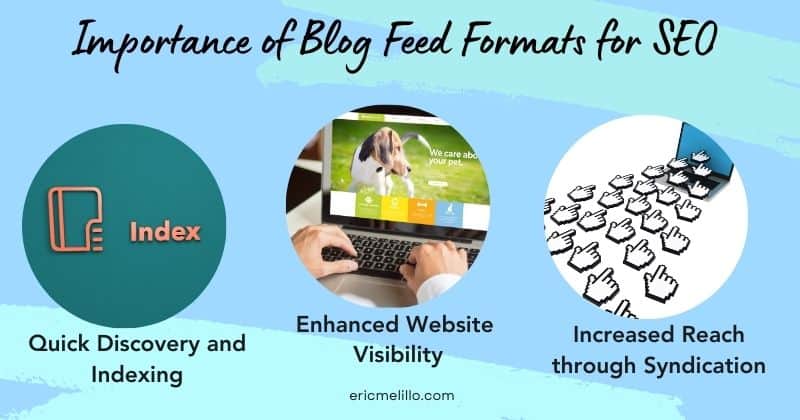Blog Feed Format, commonly known as RSS (Really Simple Syndication), is an essential tool for distributing content to a diverse audience. It streamlines sharing your latest blog entries, ensuring readers can always access your latest content without manually visiting your site.
Having developed websites and marketed content across various platforms, I’ve encountered the quirks of setting up and optimizing RSS. My hands-on experience has equipped me to guide you through making the technology work to expand your reach through newsreaders and even automations.
With a firm understanding of RSS, you ensure your blog’s voice is consistently heard by those who matter most: your readers. It’s about reliable content delivery that keeps your audience engaged and informed.
Common Types of Blog Feed Formats Explained
Understanding the different blog feed formats enhances how your audience interacts with your content, directly influencing your blog’s user-friendliness and accessibility.

Overview of RSS, Atom, BlogML, and JSON feed formats
RSS (Really Simple Syndication), Atom, BlogML, and JSON are common blog feed formats that distribute content from a website to various platforms.
- RSS is one of the oldest and most widely supported feed formats. It uses XML to organize and deliver content updates.
- Atom is another XML-based format that offers functionality similar to RSS but with more extensibility options.
- BlogML (Blog Markup Language) is an XML format that transfers blog posts between different platforms.
- JSON (JavaScript Object Notation) is a lightweight data interchange format that has gained popularity due to its simplicity and compatibility with modern web technologies.
Key features and functionalities of each blog feed format
The features and functionalities of each blog feed format are unique and cater to different needs. Here is a breakdown of the key aspects of each format:
RSS (Really Simple Syndication):
- Content Flexibility: It can deliver the full content of articles or just summaries, depending on the user’s preference.
- Customization: Namespaces can be used to introduce additional elements, making the feed more versatile.
- Compatibility: It has broad support across various feed readers, applications, and devices, making it a go-to choice for content syndication.
Atom:
- Enhanced Metadata: Atom’s improved metadata handling provides detailed information on authorship and publishing dates.
- Extensibility: It allows for greater flexibility as users can extend the capabilities of the feed with different modules.
- Pagination Support: It can manage large feeds more efficiently by supporting pagination, which helps break down the feed into smaller, more manageable parts.
BlogML (Blog Markup Language):
- Migration-Friendly: BlogML is tailored for blog content migration, ensuring a smooth transition of posts between various blogging systems.
- Preservation of Elements: It maintains the integrity of blog elements such as formatting, categories, tags, and comments during the transfer process.
JSON (JavaScript Object Notation):
- Lightweight Data Interchange Format: JSON files are typically smaller and faster to load, making them more efficient for web use.
- Ease of Parsing: A data format that’s easy to parse, especially in web environments, JSON is a favorite for developers working with modern web technologies.
- JavaScript Compatibility: JSON is naturally compatible with JavaScript, making it a seamless choice for web applications that require quick and easy data manipulation.
Compatibility with different devices and applications for content consumption
All these feed formats can be consumed by various devices and applications, such as:
- Web browsers
- Email clients
- News aggregators
- Content management systems (CMS)
Best use cases for each
The choice of blog feed format depends on specific use cases:
- RSS: Ideal for general content syndication and distribution.
- Atom: Suitable for blogs that require more metadata and extensibility options.
- BlogML: Useful when migrating blog content between different platforms.
- JSON: Well-suited for modern web applications that leverage JavaScript.
By understanding each blog feed format’s features, functionalities, compatibility, and best use cases, website owners can choose the most suitable format to distribute their content effectively.
RSS Feeds
RSS feeds have become popular for websites and blogs to distribute updates and news. The term “RSS” stands for Really Simple Syndication, a feed format many websites use.

Users can subscribe to these RSS feeds using an RSS reader or news aggregator to stay updated with the latest content from their favorite blogs and websites.
Pros of RSS Feeds
- Easy Content Distribution: RSS feeds make it simple for websites and blogs to distribute their content to a wide audience without relying on email newsletters or social media platforms.
- Time-Saving: Subscribing to an RSS feed allows users to access new content in one central location, eliminating the need to visit multiple websites individually.
- Customizable Experience: Users have control over which feeds they subscribe to, tailoring their content consumption based on their interests and preferences.
Cons of RSS Feeds
- Limited Interaction: Unlike social media platforms, RSS feeds do not typically offer features for commenting or engaging directly with the content creator.
- Learning Curve: Some users may find it challenging to initially understand how to set up and use an RSS reader.
- Incomplete Content Display: Depending on the feed format used by the website or blog, some articles may only display a summary instead of the full text. Users then need to click through to the source for complete information.
Atom Feeds

Atom feeds are a popular feed format used by news aggregators and blog readers. They provide a standardized way to distribute and syndicate content on the web. Using XML markup, Atom feeds structure and organizes information in a way that is easy for services and industry players to support.
Pros & Cons
Pros of Atom Feeds:
- Standardized Format: Atom feeds follow a well-defined standard, making it easier for different platforms and applications to consistently consume and display the feed content.
- Rich Metadata: Atom feeds allow for the inclusion of additional metadata such as author information, publication dates, categories, and more. This helps enhance the context and organization of the content.
- Extensibility: The extensible nature of Atom feeds allows developers to add custom elements or attributes specific to their needs, providing flexibility in how the feed is utilized.
Cons of Atom Feeds:
- Complexity: Working with XML markup can be more complex compared to other simpler formats like JSON. This may require additional effort from developers when implementing or consuming Atom feeds.
- Lower Adoption: While Atom feeds have been widely adopted in certain domains like blogging, they may not be as prevalent as RSS feeds in other areas. This could limit the availability of tools or services specifically tailored for working with Atom feeds.
JSON Feed: The Newcomer in Blog Feed Formats
JSON Feed has emerged as a newcomer in blog feed formats, offering a simplified approach to managing and distributing content. Utilizing the JSON (JavaScript Object Notation) format streamlines the process of creating and consuming blog feeds for both publishers and readers.

Simplifying blog feeds with JSON format
Unlike traditional XML-based RSS feeds, which can be complex and difficult to parse, JSON Feed presents a more straightforward structure.
It organizes data in key-value pairs, extracting relevant information from the feed more easily. This simplicity benefits developers who work with these feeds and enhances the overall user experience for readers.
Benefits of using JSON Feed for publishers and readers
Publishers can take advantage of several benefits when adopting JSON Feed as their preferred format:
- Simplicity: With its concise syntax, JSON Feed reduces the complexity of generating and maintaining blog feeds. This allows publishers to focus on creating quality content rather than wrestling with complicated markup.
- Compatibility: JSON is widely supported across programming languages and platforms, ensuring broad compatibility for publishing tools and applications. Publishers can distribute their content seamlessly to various news aggregators and RSS readers.
- Enhanced functionality: JSON supports additional features such as attachments, allowing publishers to include multimedia content directly within their feed entries. This enriches the reading experience by providing images or videos alongside text-based articles.
Readers also reap benefits when consuming blogs through JSON Feeds:
- Faster loading times: Due to its lightweight nature, parsing JSON Feeds requires less processing power than XML-based counterparts. As a result, readers can enjoy faster loading times when accessing their favorite blogs or news sources.
- Improved readability: The simplified structure of JSON Feeds makes it easier for readers to navigate through articles and find relevant information quickly. Including multimedia attachments enhances the visual appeal and engagement of the content.
BlogML: The XML-Based Blogging Standard
BlogML is an XML-based blogging standard used for blog feed format. It allows blogs to be easily syndicated and read by news aggregators and RSS readers.

Compatibility with Various Feed Formats
BlogML uses markup similar to HTML, making it compatible with various feed formats like RSS and RDF. This compatibility ensures that blogs in the BlogML format can be easily integrated into different platforms and consumed by a wide range of readers.
Comparing BlogML to Other Blog Feed Formats- Pros & Cons
When comparing BlogML to other blog feed formats, there are several pros and cons to consider:
Pros:
- Easy Syndication: BlogML simplifies the process of syndicating blogs by providing a standardized format that news aggregators and RSS readers can easily understand.
- Compatibility: Due to its HTML-like markup, BlogML is compatible with popular feed formats like RSS and RDF, ensuring broad accessibility.
- Structured Data: The XML structure of BlogML allows for organized storage of blog content, making it easier to manage and manipulate data.
Cons:
- Complexity: As an XML-based standard, implementing BlogML may require some technical expertise.
- Limited Features: While BlogML provides the basic elements necessary for blog syndication, it may lack some advanced features in other formats.
Importance of Blog Feed Formats for SEO
Understanding blog feed formats boosts your site’s visibility on search engines. These formats help distribute content widely, making it easier for more people to find you.

Quick Discovery and Indexing
Blog feed formats play a crucial role in helping search engines discover and index new content quickly. By utilizing these formats, websites can provide a structured and standardized way for search engine bots to crawl their content efficiently.
This means that when new blog posts or updates are published, search engines can promptly detect them, ensuring faster indexing and visibility in search results.
Enhanced Website Visibility
Using blog feed formats can significantly impact the visibility of a website in search results. When search engines have easy access to regularly updated content through blog feeds, they are more likely to consider the website relevant and authoritative.
As a result, the website has a higher chance of ranking better in organic search results, attracting more organic traffic.
Increased Reach through Syndication
- One of the key benefits of syndicating content through blog feed formats is its increased reach.
- By making your blog’s RSS or Atom feed available to other websites or platforms, you can expand your audience and gain exposure to a wider range of potential readers.
- This syndication helps increase traffic and enhances brand visibility and authority within your niche.
The Role of Curated Content in Marketing
Curated content is crucial in marketing strategies, providing valuable information to target audiences.
With the advent of simple syndication and news aggregators, publishers now have an easier way to distribute their blog feeds across various platforms. This has led to developing industry-standard markup for displaying updated blog feeds.
Simple Syndication and News Aggregators
Simple syndication, also known as RSS (Really Simple Syndication), allows publishers to distribute their blog content in a standardized format.
News aggregators, such as Feedly or Flipboard, collect these RSS feeds from multiple sources and present them in one convenient location. This makes it easier for readers to access and consume content from different blogs without visiting each website.

Industry-standard markup for Blog Feeds
The popularity of curated content services and websites has led to developing industry-standard markup for displaying updated blog feeds. This markup ensures that the layout and formatting of the blog feed are consistent across different platforms and devices.
By adhering to this standard, publishers can ensure their curated content is displayed correctly and attractively on various websites or apps.
Providing Valuable Information
Curated content is valuable for marketers by providing relevant and useful information to their target audiences. It allows businesses to showcase their expertise, establish thought leadership, and build trust with potential customers.
By curating high-quality articles, videos, or infographics from reputable sources within their industry, marketers can position themselves as knowledgeable authorities in their field.
Maximizing Marketing Strategies with Blog Feeds
We discussed popular formats such as RSS feeds, Atom feeds, JSON Feed, and BlogML, highlighting their features and benefits. These feed formats are key in improving search engine optimization (SEO) by ensuring that your blog content reaches a wider audience and is easily discoverable.
By effectively utilizing blog feed formats, you can enhance your marketing efforts by syndicating your content across various platforms and reaching potential customers who may not have found your blog.
Curated content can be a valuable tool in marketing strategies, allowing you to share relevant and high-quality information with your audience.
Integrating Blog Feeds with SEO Techniques
To make the most out of blog feed formats for your marketing strategy, consider implementing them alongside other SEO techniques, such as keyword optimization and link building.
By consistently providing valuable content through well-structured feeds, you can establish yourself as an authoritative source in your industry and attract more visitors to your website.
Start leveraging the power of blog feeds today to boost your marketing efforts! Here’s a quick guide:
- RSS Feeds: Automate content distribution to reach your audience directly.
- Atom Feeds: Utilize this format for enhanced content structure and detail.
- JSON Feed: Offer a more modern, easy-to-use format for developers and readers.
- BlogML: Ensure compatibility and easy content transfer between platforms.
Remember, integrating blog feeds into your marketing strategy is not just about distribution but also about creating connections with your audience. By providing consistent, high-quality content, you can turn readers into loyal followers and customers.
Over to You
With blog feed formats, it’s key to pick the right one for your site. Each type, like RSS or Atom, has its perks. This choice affects how people find and see your blog. So, think about what your readers like, what’s easy to use, and what works well on different gadgets.
If you’re ready to get your blog out there more, take a moment to look at your feed. Ask yourself if it’s doing the best for you and your readers. Sometimes, a small change can really help folks connect with your blog. And hey, if you’re not sure, maybe try a new format and see what happens!
FAQs
Why should I use blog feed formats for my website?
Blog feed formats like RSS or Atom help ensure content is easily accessible and distributable across the web, improving your website’s reach and update speed for subscribers. They also enhance SEO by alerting search engines to new content, which can lead to more frequent indexing and potentially higher rankings.
Why should I use blog feed formats for my website?
Blog feed formats like RSS and Atom allow efficient content syndication, automatically updating subscribers about new posts. This consistent engagement can improve a website’s SEO by signaling fresh content to search engines, potentially increasing visibility and driving traffic.
Which is the most popular blog feed format?
The most popular blog feed format is RSS (Really Simple Syndication). It is widely used due to its compatibility with numerous readers and services, facilitating easy content distribution and syndication for blog updates.
Can I use multiple blog feed formats on my website?
Websites can simultaneously employ multiple blog feed formats, such as RSS and Atom. This approach caters to various user preferences and software capabilities, potentially broadening content accessibility and enhancing user experience.
Are there any SEO benefits of using blog feed formats?
Using blog feed formats like RSS or Atom can improve SEO by facilitating content syndication, which helps keep subscribers updated. This continuous content distribution encourages regular indexing by search engines, thereby increasing the potential for improved site visibility and higher search rankings.
How often should I update my blog feed?
Update your blog feed regularly with fresh content to maintain a steady stream of information for your subscribers and search engines. Ideally, weekly updates are effective to stay relevant and keep your audience engaged while also signaling to search engines that your site is active.
Is RSS still a thing?
RSS feeds remain active and serve as a tool for users to directly receive updated content from preferred websites. They are useful for content syndication and help with website traffic by keeping audiences informed and engaged with regular updates.



